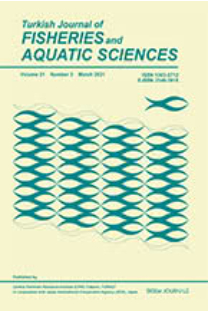Temporal variations of phytoplankton in relation to eutrophication in Samsun bay, southern Black Sea
Türkiye, ötrofikasyon, fitoplankton, zamansal değişim, Karadeniz, biyoçeşitlilik, Samsun
Güney Karadeniz, Samsun Körfezi’nde ötrofikasyona bağlı olarak fitoplanktonun zamansal değişimi
Turkey, eutrophication, phytoplankton, temporal variation, Black Sea, biodiversity, Samsun,
___
- APHA. 1998. Standard methods for the examination of water and wastewater. 19th Ed., American Public Health Association, Washington D.C.
- Bat, L., Sahin, F., Satılmıs, H.H., Ustun, F., Ozdemir, Z.B., Kideys, A.E. and Shulman, G.E. 2007. Karadeniz’in değişen ekosistemi ve hamsi balıkçılığına etkisi. J.Fish Sci. Comm., 1(4): 191-227.
- Bodeanu, N. 1984. Modifications sous l’influence anthropique dans le developementquantitatif et dans la structure du phytoplancton du secteur roumain de la Mer Noire.Trav. Mus. Hist. Nat.Gr. Antipa, Bucuresti, 26: 69-83.
- Clarke, K.R. and Warwick, R.M. 2001. Change in marine communities: an approach to statistical analysis and interpretation. 2nd Ed., Primer-E, Plymouth, England, 190 pp.
- Cupp, E.E. 1943. Marine plankton diatoms of the west coast of North America. Bull. Scripps Inst. Oceanogr., 5: 1- 237.
- Fritz, L. and Triemer, R.E. 1985. A rapid simple technique utilizing calcofluor white M2R for visualization of dinoflagellate thecal plates. J. Phycol., 21: 662-664.
- Gionovardi, F. and Vollenweider, R.A. 2004. Trophic conditions of marine coastal waters: experience in applying the Trophic Index TRIX to two areas of the Adriatic and Tyrrhenian Seas. J. Limnol., 63: 199- 218.
- Gucu, A.C. 2002. Can overfishing be responsible for the successful establishment of Mnemiopsis leidyi in the Black Sea? Estuar. Coast. Shelf Sci., 54: 439-451.
- Guillard, R.R.Y. 1978. Counting slides. In: A. Sournia (Ed.), Phytoplankton Manual, UNESCO, Paris: 182- 189.
- Hasle, G.R. and Syvertsen, E.E. 1996. Marine diatoms. In: C.R. Tomas (Ed.), Identifying marine phytoplankton, Academic Press, San Diego: 5-385.
- Hasle, G.R., Lange, B.C. and Syvertsen, E.E. 1996. A review of Pseudonitzschia, with special reference to the Skagerrak, North Atlantic and adjacent waters. Helgoland, 50: 131-175.
- John, D.M., Whitton, B.A. and Brook, A.J. 2003. The Freshwater Algal Flora of the British Isles: An identification guide to freshwater and terrestrial algae, The Natural History Museum and The British Phycological Society, Cambridge University Pres, Cambridge.
- Kirk, J.T.O. 1994. Light and photosynthesis in aquatic ecosystems, 2nd Ed., Cambridge University Press, Cambridge, 401 pp.
- Konovalov, S.K. and Murray, J.W. 2001. Variations in the chemistry of the Black Sea on a time scale of decades (1960-1995). Journal of Marine Systems, 31: 217-243.
- Konovalov, S.K., Murray, J.K. and Luther III, G. 2005. Basic processes of Black Sea Biochemistry. J. Oceanogr., 18: 24-35.
- Mee, L.D., Friedrich, J. and Gomoiu, M.T. 2005. Restoring the Black Sea in times of uncertainty. J. Oceanogr., 18: 100-111.
- Oğuz, T., Malanotte-Rizzoli, P., Duckow, H.W. and Murray, W. 2002. Interdisciplinary studies integrating the Black Sea biogeochemistry and circulation dynamics. J. Oceanogr., 15: 4-11.
- Oguz, T. 2005a. Long-term impacts of anthropogenic forcing on the Black Sea ecosystem. J. Oceanogr., 18: 112-121.
- Oguz, T. 2005b. Black Sea ecosystem response to climatic teleconnections. J. Oceanogr., 18: 122-133.
- Pinarli, V., Onar, N., Ozkoc, H. and Buyukgungor, H. 1991. Pollution in Samsun coast of Black Sea. In: The Black Sea Symposium, Istanbul 16-18 September, Ecological Problems and Economical Prospects, İstanbul: 127-134.
- Rampi, L. and Bernhard, M. 1978. Key for the determination of Mediterranean pelagic diatoms. C.N.E.N, Italy.
- Shumway, S.E. 1990. A rewiev of the effects of algal blooms on shelfish and aquaculture. J. World Aquacult. Soc., 21: 65-104.
- Sorokin, Y.I. 2002. The Black Sea: ecology and oceanography. Backhuys Publishers, Leiden, The Netherlands, 875 pp.
- Steidinger, K.A. and Tangen, K. 1996. Dinoflagellates. In: C.R. Tomas (Ed.), Identifying Marine Phytoplankton, Academic Press, San Diego: 387-584.
- Stonik, I.V. and Selina, M.S. 1995. Phytoplankton as an indicator of eutrophic levels of water in Peter the Great Bay, Sea of Japan. Biol. Morya., 21: 403–406.
- Throndsen, J. 1996. The planktonic marine flagellates. C.R. Tomas (Ed.), Identifying marine phytoplankton, Academic Press, San Diego: 591-729.
- Tregouboff, G. and Rose, M. 1957. Manuel de planctonologie Mediterraneenne. Paris: Centre National De la Recherche Scientifique, Paris, 587 pp.
- Trobajo, R.P. 2007. Ecological analysis of periphytic diatoms in Mediterranean coastal wetlands (Emporda wetlands, NE Spain). Diatom Monogr., 7: 1-210.
- Yilmaz, A. 2002. Biogeochemistry of the Turkish seas: distributions and transformations (in Turkish). Turk. J. Eng. Env. Sci., 26: 219-235.
- Vollenweider, R.A., Gionovardi, F., Montanari, G. and Rinaldi, A. 1998. Characterization of the trophic conditions of marine coastal waters with special reference to the NW Adriatic Sea: proposal for a trophic scale, turbidity and generalized water quality index. Environmetrics, 9: 329-357.
- Zaitsev, Y.V. and Mamaev, V.O. 1997. Biological Diversity in the Black Sea: A Study of Change and Decline. Black Sea Environmental Series, Vol. 3.
- ISSN: 1303-2712
- Yayın Aralığı: 12
- Başlangıç: 2015
- Yayıncı: Su Ürünleri Merkez Araştırma Enstitüsü - Trabzon
PCDD/F, dl-PCB and indicator PCBs in whiting, horse mackerel and anchovy in Black Sea in Turkey
Gül Çelik ÇAKIROĞULLARI, Yunus UÇAR, Berrin OYMAEL, Edibe Nurzen BOZKURT, Devrim KILIÇ
Serden BAŞAK, Gülgün F. ŞENGÖR, Fatma KARAKOÇ TELLİ
Şevket KANDEMİR, İbrahim ÖRÜN, Zeliha TALAS SELAMOĞLU, Gül Nihal ÖRÜN, Kenan ERDOĞAN, Mustafa IŞIK, Levent ALTAŞ, Ayhan DURAN
K.N. VARALAKSHMI, Ravichandra REDDY
Pınar Yerlikaya KEBAPÇIOĞLU, Nalan GÖKOĞLU
Beyhan TAŞ, Arif GÖNÜLOL, Erol TAŞ
R. AL-TAMEEMI, A. ALDUBAIKUL, N.A. SALMAN
Serap COSANSU, Sühendan MOL, Üçok Didem ALAKAVUK
